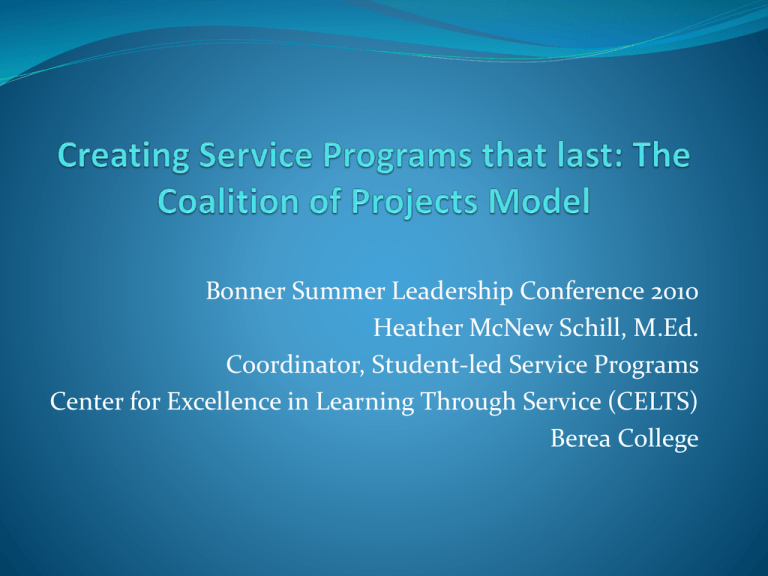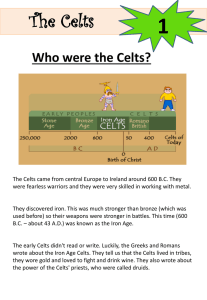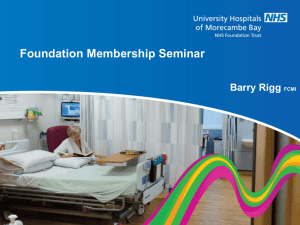The Coalition of Projects Model
advertisement

Bonner Summer Leadership Conference 2010 Heather McNew Schill, M.Ed. Coordinator, Student-led Service Programs Center for Excellence in Learning Through Service (CELTS) Berea College Welcome to the session Who is in the room? Please share your name, school and why you came to this session Who am I? Coordinator of Student-led Service Programs at Berea College Supervise around 80 college students (through the Berea College Work Study Program), which coordinate 10 community service programs and supervise approximately 200 college student volunteers using the Coalition of Project Model The Coalition of Projects Model I first learned of this model at the 2002 COOL Conference. I attended a day long forum called Building It Up: A One Day institute on building and strengthening campus-based community service programs led by John Hoang Sarvey. John was a staff member at COOL, who later went on to work as the Executive Director of City Year. The Model Consists of the following: 1. Umbrella organization of multiple projects 2. Issue or neighborhood focused projects 3. Group coordination of volunteers 4. Cascading Leadership structure 5. Coalition-wide support functions for the projects 6. Systematic training of project leaders 7. Systematic exchange of challenges and best practices among projects 8. Systematic quality improvement process 9. New Project incubator 10. Office space that’s student-oriented, has a “hang-out” quality Umbrella organization of multiple projects- The Model Cannot be just one single student organization, but instead it should be a system of several organizations Overall program serves as an umbrella to combine resources, expertise and effective systems Each program has its own leadership and volunteer base Project Leaders (students) feel the primary responsibility for their project, not their staff supervisor Project Leaders are developed from among volunteers Umbrella organization of multiple projectsHow It Works in CELTS Each of the 10 Student-led Programs are officially recognized as a separate club/organization CELTS serves as the umbrella for student-led community service and academic service-learning Student Program Coordinators are responsible for the leadership of their specific program. They are responsible for the selection and training of their volunteers No one can become a team member in a program with out first being a volunteer Coordinator, Student-led Service Programs CELTS Student Director Student Program Coordinator Student Program Student Program Coordinator Coordinator Student Team Members Student Team Student Team Members Members Volunteers Volunteers Volunteers Issue or specific community focused project- The Model Each project/program has a specific and unique focus: Focus could be on specific issues, a specific community, or organizational affiliation Volunteer recruitment is made on the basis of specific issues rather than the general concepts of volunteerism or community service Issue or specific community focused projectHow it works in CELTS Each of the studentled programs has a different issue focus and population served. Two have affiliations with national organizations Each program recruits its own volunteers at the annual Volunteer Extravaganza, where potential volunteers choose the specific program in which they wish to work Group Coordination of VolunteersThe Model Volunteers work in groups or teams, rather than individual placements This encourages informal (or formal) orientation, reflection and accountability This leads to a sense of community and support Group Coordination of VolunteersHow it works in CELTS • Each student-led program has a Student Coordinator and a team of 2 to 4 students working for them • Student Coordinators are responsible for the orientation, reflection and accountability of their team members and volunteers • I would hope our students feel a sense of community.. Cascading Leadership StructureThe Model Utilizes successive sets of student leaders who spend 3 or 4 years with the same project/program Often students start as a volunteer, become a assistant project leader, project leader and then serve in some support or leadership role for the overall organization This structure allows for students to develop skills and experiences to run their projects independently Volunteers Cascading Leadership Structure- How it works in CELTS Team Members Program Coordinators This is the exact structure of our student-led programs Student Director Students begin working for us as volunteers and are able to move their way up to Team Members, Program Coordinators and CELTS Student Director Student leaders develop skills which they in turn help teach the younger students- both volunteers and team members Student Director Program Coordinators The Training Cycle Volunteers First Year Team Members Second Year Team Members Coalition-wide support functions for the projects- The Model There is a coalition-wide group of student leaders who help support project leaders in areas such as recruitment, funding, training, etc. Project Leaders know and utilize the assistance they can receive from coalition-wide leaders Coalition-wide leaders are experienced and ideally have former project leadership experience Coalition-wide support functions for the projects- How it works at CELTS Student Leadership Team In CELTS, the coalitionwide student leaders are called the Student Leadership Team These three students represent the three areas of CELTS programming: Student-led Service Programs, Bonner Scholars and Academic Service-Learning All three of these students have previously served as a Student Coordinator in their particular program area ServiceLearning Associate (Academic Service-Learning) CELTS Student Director (Student-led Service Programs) Bonner Senior Intern (Bonner Scholars Program) Systematic training of project leadersThe Model Project Leaders participate in a comprehensive training program which covers all the different areas of project management, including volunteer recruitment, funding, program development, community relations, reflection, etc. Sometimes this training is also offered as an academic course Systematic training of project leadersHow it works at CELTS •In CELTS all our student leaders meet once a week for a training session. These sessions vary from specific skill development to awareness events and guest speakers •Student Coordinators also attend a separate training each week in addition to the all student meeting above •Unfortunately, none of our training programs are offered as an academic course Skill Trainings Personal Leadership Skills Skills Professional Skills Conflict resolution Budgeting Decision making Delegation Evaluation/research Organization Active listening Planning Event planning Public speaking Fundraising Running a meeting Grant writing Teamwork Marketing / public relations Planning Balance/boundaries Communication Reflection Time management Goal setting Understanding civic engagement Understanding public policy Working with diverse groups Mediation Networking Public education / advocacy Volunteer management Systematic exchange of challenges and best practices among projectsThe Model Regular opportunities exist for projects to share successful practices and challenges with each other This helps to uncover innovative and effective approaches to different issues Systematic exchange of challenges and best practices among projectshow it works in CELTS •Student Coordinators are provided with an opportunity to share both best practices and challenges at a weekly meeting we call the Core Staff meeting •Specialized training for Student Coordinators also take place at this weekly meeting Systematic quality improvement processThe Model Some sort of qualitative program development occurs each year, which could include annual proposals and regular progress reports An ideal system would include an outside funding board external to the program Systematic quality improvement processHow it works in CELTS Student Coordinators are required to submit program updates monthly and an annual end of the year report, used to evaluate each program Each student worker (both Team Members and Student Coordinators) in CELTS receives a formal mid-term and end of year evaluation of their work and on-going informal Recently, a quantitative study showed that both CELTS student workers and volunteers graduated at a significantly higher rate and had a significantly higher GPA than those who did not work for CELTS or volunteer with CELTS The student-led programs of CELTS do not have an external funding board. All funding comes from Berea College, however, our Bonner Scholars Program is endowed by The Bonner Foundation New Project Incubator- The Model The umbrella organization should have a clear system for adding or developing new projects which includes criteria and expectations Coalition staff should be able to articulate the value of joining the coalition New Project IncubatorHow it works at CELTS •In the last few years, several new projects and programs have been added to the student-led programs to address the needs of the community •We are often approached by people wanting to start new programs and projects; however, it takes a lot of time and consideration before a program “officially” joins CELTS Student Office space with a “hang out” quality- The Model Office space should provide a sense of community and home base on campus Students should be drawn to come back between classes and other activities Informal conversations will help students strengthen the community Each program should have its own identifiable space in the office, which includes a phone and an actual desk Student Office space with a “hang out” quality- How it works at CELTS •Each of our studentled programs has its own identifiable office space with a desk and phone. Each program is allowed to decorate their space in any way they choose •Students are always in their office space, where informal conversations often lead to program collaborations Want to learn more? Check out the CELTS web page: www.berea.edu/celts Give me a call or send me an email Come visit us in Berea Heather McNew Schill CPO 2170 Berea College Berea, KY 40404 (859) 985-3804 Heather_Schill@berea.edu









